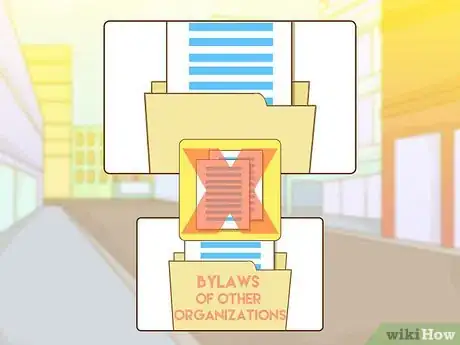This article was co-authored by Clinton M. Sandvick, JD, PhD. Clinton M. Sandvick worked as a civil litigator in California for over 7 years. He received his JD from the University of Wisconsin-Madison in 1998 and his PhD in American History from the University of Oregon in 2013.
wikiHow marks an article as reader-approved once it receives enough positive feedback. In this case, 91% of readers who voted found the article helpful, earning it our reader-approved status.
This article has been viewed 156,284 times.
The bylaws of a nonprofit corporation set forth the rules that govern the operation of the organization. They contain the rules and procedures for holding meetings, electing directors, appointing officers, and taking care of other essential formalities. As a nonprofit evolves and changes, its bylaws should be periodically reviewed and amended to respond to these changes. For example, a growing nonprofit may want to expand the size of its board or redefine some of its members' duties. If a nonprofit cannot show that its actions conform to the requirements of its bylaws, it will be vulnerable to lawsuits by its members, auditors or vendors.
Steps
Drafting Your Proposed Amendment
-
1Understand your state's nonprofit corporation law. A nonprofit is governed by the statute in the state in which it was incorporated. Before you draft a bylaw or amendment to an existing bylaw, it is important that you review your state's nonprofit corporation statute to understand its default provisions and the practices it prohibits.
- Confirm the change you wish to make is not prohibited by state law. If so, the amendment will have no effect and any actions taken pursuant to it will be null and void. For example, the Washington State Nonprofit Act provides: "in no event shall a quorum consist of less than one-third of the number of directors so fixed or stated.”[1] This means that any bylaw in Washington State that allows for a quorum of less than one third would not be valid.
- Refer to the default provisions in your nonprofit corporation law, such as the minimum number of votes needed in a vote by the Board of Directors. If you wish to override them, amend your bylaws to reflect this change.
- In planning how you will hold a vote to secure approval for your amendment, review how members (if there are voting members) and directors are permitted to meet and vote under state law. Many state nonprofit corporation acts do not allow directors to vote by proxy, Instead, a director is required to attend the meeting in-person or via telephone to be counted as present at the meeting for purposes of quorum and voting.
-
2Make sure your proposed amendment is consistent with other regulatory documents. In addition to ensuring your proposed bylaw conforms with your state's nonprofit corporation statute, you should also check it is consistent with the non-profit's articles of incorporation and, if applicable, other relevant statutes.
- If your organization is governed or licensed by a state agency, such as the Department of Education or Department of Banking, review state laws in those areas for additional mandatory bylaw provisions.
- For example, if you wish to amend the bylaws of a Home Owner's Association, you must refer to both your state's nonprofit statute and its Home Owner's Association Act. If the Home Owner's Association Act specifies that board meetings must be open to members, your bylaws must allow for members to attend board meetings, even if your state nonprofit statute does not require it.[2]
Advertisement -
3Don't rely on language found in bylaws of other organizations. Avoid taking the language for your proposed bylaw from the bylaws of other organizations. The bylaws of another organization may:
- Not be in compliance with the law in your state.
- Not include important provisions that apply to your organization by default under applicable law.
- Not have been customized to meet the needs of your organization.
-
4Address all foreseeable scenarios. Think about all of the possible scenarios that could arise in relation to your proposed amendment and address them in the language of the bylaw.
- For example, if your amendment describes the process for removing a board member, you also need to include a provision for filling the position upon his removal.
-
5Have a lawyer review the amendment. If you have any doubts about your proposed amendment or plan to amend the bylaws in a way that will alter them substantially, ask a lawyer who specializes in nonprofit law to review all of your draft amendments. A lawyer will be able to spot inconsistencies and potential problems with the proposal.
- For example, a lawyer will be familiar with your state's nonprofit statute and will be able to catch provisions in your draft that may be invalid because they conflict with minimum requirements under the law. If you live in a city, your lawyer will also be familiar with city regulations that affect your bylaws, such as requiring that an elected official or government employee serve on your board.[3]
-
6Be prepared to explain why the amendment is needed. In order to secure approval for your bylaw, you will need to convince the Board that your amendment is needed. Generally, two-thirds of the Board will need to vote in your favor. For this reason, it is important to consider what reasons you will give to justify amending the current bylaws.[4]
- For example, if the activities of your organization no longer fall within the scope of your mission, you will need to amend your mission statement. Prepare to explain what activities were originally envisioned for the organization, how they have evolved and what specific revisions to the mission statement would reflect this new reality. [5]
Securing Approval
-
1Review the current bylaws. The rules for amending a nonprofit’s bylaws are contained within the bylaws themselves. To ensure that you amend your bylaws in a way that will not be challenged in court, review the current bylaws for the exact procedures required.[6]
- Look for the percentage of the Board that must vote in your favor (usually two-thirds).
- Look for what kind of notice you are required to give the Board before putting the amendment to a vote.
- If the members of your organization also have voting powers, look for what percentage of the voting members must vote in favor of an amendment and what kind of notice they must be given.
- Keep in mind that the process for amending bylaws is the same regardless of whether you wish to modify existing provisions, add new provisions, or delete provisions.
-
2Notify the Board of Directors of your proposed amendment. If required by your bylaws, you will need to give the members of your Board notice of your proposed amendment before holding a vote to determine whether or not to approve it.[7]
- Put your proposed amendment in writing and circulate it among the members of the Board so they have a chance to ask you questions about it and consider whether or not to vote in favor of it.
- Preface the draft amendment with an explanation for why you believe the amendment is necessary.
-
3Hold a vote of the Board of Directors on the amendment. Request that the Board meet to discuss your proposed amendment and vote on whether to approve it. [8]
- If the proposed amendment is a minor one and your bylaws do not require you to give the members of the Board notice of the proposal before the meeting, you may propose the amendment and vote at the same meeting.
- Follow the rules set forth in the bylaws for who must be at the meeting, how many must attend the meeting, and the percentage of votes necessary for the amendment to pass in order for the vote to be valid.
- Record the outcome of the vote and keep a copy with your other corporate papers.
-
4Write the amendment into the bylaws. Once you have secured the necessary approval for your amendment, draft a new document that contains your complete bylaws, including the amendment. Circulate the new bylaws among the members of the Board and any other relevant individuals.
-
5Inform the IRS. If your nonprofit is recognized as tax-exempt by the IRS, you are obligated to notify the IRS of any "structural or operational" changes to your bylaws.[9]
- An example of a structural or operational change would be the creation of a new program.
- If this is your case, either submit the amended bylaws or a letter describing the changes to the IRS Exempt Organizations Determinations Office or report the changes by filing Form 990 or Form 990-EZ.
Expert Q&A
Did you know you can get expert answers for this article?
Unlock expert answers by supporting wikiHow
-
QuestionDoes each bylaw change need to be voted on separately?
 Barzin Barry Sabahat, JDBarry Sabahat, Esq. has been practicing law in California since 1993. He received his JD from Western State University College of Law in 1992. His current practice is based in the San Francisco Bay Area and focuses on Estate Planning, Transactional Law and drunk driving cases.
Barzin Barry Sabahat, JDBarry Sabahat, Esq. has been practicing law in California since 1993. He received his JD from Western State University College of Law in 1992. His current practice is based in the San Francisco Bay Area and focuses on Estate Planning, Transactional Law and drunk driving cases.
Attorney at Law No. Any number of matters up for vote can be voted on in the same meeting. Usually, proposed changes to bylaws are sent to the board members in advance of the meeting so that the members have an opportunity to review and discuss changes and their ramifications before they vote. Whether more than one change to the bylaws can be put in a single resolution is a matter of strategy, but there is no requirement that each single change to the bylaws must have a separate resolution.
No. Any number of matters up for vote can be voted on in the same meeting. Usually, proposed changes to bylaws are sent to the board members in advance of the meeting so that the members have an opportunity to review and discuss changes and their ramifications before they vote. Whether more than one change to the bylaws can be put in a single resolution is a matter of strategy, but there is no requirement that each single change to the bylaws must have a separate resolution. -
QuestionDo you put the amendments in the bylaws after the article that it affects, or as the last page?
 Barzin Barry Sabahat, JDBarry Sabahat, Esq. has been practicing law in California since 1993. He received his JD from Western State University College of Law in 1992. His current practice is based in the San Francisco Bay Area and focuses on Estate Planning, Transactional Law and drunk driving cases.
Barzin Barry Sabahat, JDBarry Sabahat, Esq. has been practicing law in California since 1993. He received his JD from Western State University College of Law in 1992. His current practice is based in the San Francisco Bay Area and focuses on Estate Planning, Transactional Law and drunk driving cases.
Attorney at Law A change in the bylaws is usually separate from the bylaws themselves. They are named stating the number amendment. For example, "First Amendment to Acme Mousetrap Corporation's Bylaws." In the body of the amendment,you also need to state the article that will be removed and state the new article in full.
A change in the bylaws is usually separate from the bylaws themselves. They are named stating the number amendment. For example, "First Amendment to Acme Mousetrap Corporation's Bylaws." In the body of the amendment,you also need to state the article that will be removed and state the new article in full.
References
- ↑ http://www.parli.com/newsletter/bylaws-for-non-profit-organizations-conforming-to-state-codes
- ↑ http://www.parli.com/newsletter/bylaws-for-non-profit-organizations-conforming-to-state-codes
- ↑ http://www.blueavocado.org/content/bylaws-checklist
- ↑ http://yourbusiness.azcentral.com/can-nonprofits-bylaws-amended-21266.html
- ↑ http://www.nonprofitlawblog.com/nonprofit-bylaws-common-issues/
- ↑ http://yourbusiness.azcentral.com/can-nonprofits-bylaws-amended-21266.html
- ↑ http://yourbusiness.azcentral.com/can-nonprofits-bylaws-amended-21266.html
- ↑ http://info.legalzoom.com/amend-constitution-bylaws-corporation-23903.html
- ↑ http://yourbusiness.azcentral.com/can-nonprofits-bylaws-amended-21266.html
About This Article
When a nonprofit grows, its bylaws will need to be periodically reviewed and amended to reflect these changes. Check to make sure what you're proposing is legal and follows the nonprofit laws in your state. To ensure that your amendment will not be blocked in court, review the current bylaws so you know what procedures are required. You can then request that the Board meet to discuss your proposed amendment and vote on whether to approve it. Once you secure the necessary approval for your amendment, you can draft new bylaws. To learn how to inform the IRS of any changes in your nonprofit’s bylaws, keep reading!














(3)-Nonprofit-Organization-Step-19-Version-2.webp)




















(3)-Nonprofit-Organization-Step-19-Version-2.webp)



































